品牌:奥林巴斯
起订:1台
供应:100台
发货:3天内
信息标签:5072PR,供应,仪器仪表,分析仪器
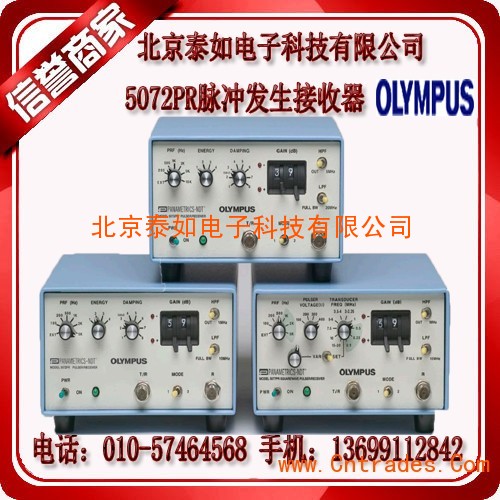

奥林巴斯5072PR/5073PR/5077PR/北京泰如服务中心5072PR/5073PR/5077PR新旧热卖
奥林巴斯5072PR/5073PR/5077PR/北京泰如服务中心5072PR/5073PR/5077PR新旧热卖
奥林巴斯5072PR,5073PR,5077PR脉冲接收器规格及参数
Panametrics-NDT Olympus
北京泰如电子科技有限公司
电话:010-57464568
手机:13699112842
QQ:3081402071
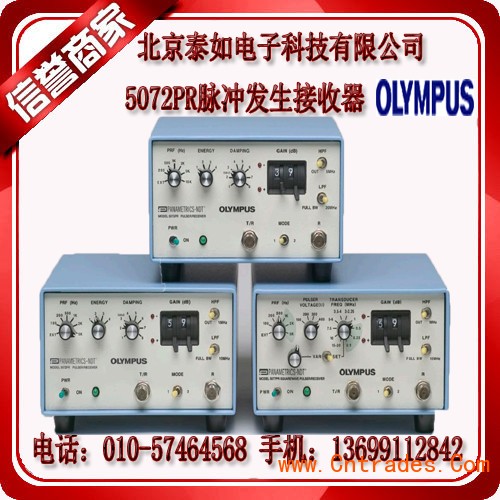
奥林巴斯5072PR,5073PR,5077PR脉冲接收器规格及参数 脉冲发生器 5072PR 5073PR 5077PR 脉冲式 (主要一声): 负 负脉冲 负方波 上升时间 (10%至90%): 通常为5类,10 ns**值 通常2纳秒 通常情况下10类,20 ns**值 (上升和下降时间) 可用脉冲电
奥林巴斯5072PR,5073PR,5077PR脉冲接收器规格及参数
北京泰如电子科技有限公司
电话:010-57464568
手机:13699112842
QQ:3081402071
|
脉冲发生器 |
5072PR |
5073PR |
5077PR |
|
脉冲式 (主要一声): |
负 |
负脉冲 |
负方波 |
|
上升时间 |
通常为5类,10 ns**值 |
通常<2纳秒 |
通常情况下“10类,20 ns**值 |
|
可用脉冲电压:(空载) |
-360 V |
-180 V |
选择-400 V,-300 V,-200 V,-100 V |
|
可用脉冲能量: |
13,26,52或104μjoules |
2,4,8,或16μjoules |
ñ /阿 |
|
阻尼: |
选择15,17,20,25,36,50, |
12,14,17,20,25,33,50或 |
ñ /阿 |
|
脉冲宽度: |
ñ /阿 |
ñ /阿 |
10个预设固定宽度:15-20,10,7.5,5.0-6.0,3.5-4.0,2-2.25,1.0,0.5,0.25,0.1兆赫。 |
|
模式: |
超声波测厚仪 |
脉冲回波或直通传输 |
|
|
隔离(53分贝分钟): |
通常在10兆赫六十二分贝 |
通常在50兆赫六十二分贝 |
通常在10兆赫六十二分贝 |
|
脉冲重复率: |
100,200,500,1000,2000或5000赫兹 |
200,500,1000,2000,5000,10000,或20000 |
100,200,500,1000,2000,5000赫兹,但**的PRF限于:0.5兆赫tranducers 2000赫兹,1000兆赫0.25兆赫传感器,50赫兹,0.1 MHz的传感器。 |
|
脉冲重复率: |
0-6千赫 |
0-10千赫 |
0-5千赫(PRF的观察与脉冲宽度的限制) |
|
同步输出脉冲: |
3伏到50欧姆 |
||
|
外部触发输入: |
酚醛为2.4?1000 |
酚醛为2.4?1000 |
酚醛为2.4?1000 |
|
奥林巴斯5072PR,5073PR,5077PR脉冲接收器参数 |
|||
|
接收机 |
5072PR脉冲接收器 |
5073PR脉冲接收器 |
5077PR脉冲接收器 |
|
**带宽: |
1千赫 - 35兆赫 |
1千赫 - 75兆赫 |
1千赫 - 35兆赫 |
|
电压增益: |
0-59,1 dB步进(当RL = 50欧姆) |
0-39,1 dB步进(当RL = 50欧姆) |
0-59,1 dB步进(当RL = 50欧姆) |
|
**阶段: |
反相或非反相(内部开关) |
||
|
衰减范围: |
0-59,1 dB步进(当RL = 50欧姆) |
0-49,1 dB步进(当RL = 50欧姆) |
0-49,1 dB步进(当RL = 50欧姆) |
|
高通滤波器: |
1千赫(出)或1 MHz |
1千赫(出)或5兆赫 |
1千赫(出)或1 MHz |
|
低通滤波器: |
35兆赫(出)或10 MHz |
75兆赫(出)或20 MHz |
35兆赫(出)或10 MHz |
|
噪音: |
70μV的的PK - PK的典型,简称输入,35兆赫带宽= |
200μV的的PK - PK的典型,简称输入,75兆赫带宽= |
70μV的的PK - PK的典型,简称输入,35兆赫带宽= |
|
**信号输出: |
+ / - 1V的峰。,终止50欧姆 |
||
|
输入电阻: |
线性范围为500欧姆 |
线性范围为100欧姆 |
500欧姆 |
|
输出阻抗: |
50欧姆 |
50欧姆 |
50欧姆 |
|
**输入功率: |
400毫瓦 |
400毫瓦 |
500毫瓦 |
|
奥林巴斯5072PR,5073PR,5077PR脉冲接收器特性 |
|||
|
单位 |
5072PR,5073PR,5077PR |
||
|
输入/输出: |
外部触发输入,同步输出,射频输出,吨/ R和R:所有BNC母头连接器 |
||
|
权力的主要要求: |
100/120/220/240伏交流电,50/60赫兹 |
||
|
工作温度: |
0-50 ° C间 |
||
|
尺寸和重量: |
7“宽x 3.5”高x 9.1“D类(178毫米x 89毫米× 232毫米); 5磅(2.3公斤) |
||
订购信息:每个型号是手工附带一个电源线和经营者。 传感器和电缆单独出售。 我们的销售部门提供详细讨论您的应用程序,并协助传感器的选择。
The 5072PR, 5037PR, and 5077PR manually controlled ultrasonic pulser-receivers are for both conventional and high frequency applications.
These affordable and reliable manually controlled pulser-receivers provide the perfect building blocks for both conventional and high frequency applications. Each instrument is designed for superior low noise receiver response and high performance pulser control.
When used with an appropriate transducer and analog or digital oscilloscope, Panametrics pulser-receivers provide the perfect starting point for ultrasonic flaw detection, thickness gaging, materials characterization, and transducer characterization.
• Three models provide optimization for both conventional and high frequency applications
• Broadband Spike (5072 and 5073) or Tunable Square Wave (5077) transducer excitation models available
• Front panel controls permit quick and easy setup of parameters for optimizing signal response
• Each model delivers a wide dynamic range with 1 dB sensitivity adjustments made through a front panel lever switch
• Low noise receiver amplification and pulser optimization ensure superior signal-to-noise characteristics
• Superior isolation of receiver from pulser main bang when operating in thru-transmission mode
• +/-1 volt RF output into 50 ohm load
• Small, lightweight packaging
Model 5072PR: 35 MHz (-3 dB) ultrasonic bandwidth and spike pulser is ideal for general testing. The impulse pulser provides optimal broadband excitation resulting in superior time domain recovery especially at higher frequencies (between 15-30 MHz).
Model 5073PR: 75 MHz (-3 dB) ultrasonic bandwidth with fast rise time spike pulser extends performance for work with 50 MHz transducers in applications that challenge limits in axial and near surface resolution.
Model 5077PR: 35 MHz (-3 dB) ultrasonic bandwidth and square wave pulser-receiver is ideal for maximizing response in scattering materials. The square wave pulser is particularly advantageous when testing with transducers of 10 MHz or lower, as adjustable pulse width optimizes pulse energy, resulting in superior signal-to-noise characteristic.
Pulser-receivers employed with ultrasonic transducers and an analog or digital oscilloscope are the prime building blocks of any ultrasonic test system.
The pulser section produces an electrical pulse to excite a transducer that converts the electrical input to mechanical energy, creating an ultrasonic wave. In pulse-echo applications, ultrasound travels through the test material until it is reflected from an interface back to the transducer. In thru- transmission applications, the ultrasound travels through the material to a second transducer acting as a receiver.
In either case, the transducer reconverts the mechanical pulse into an electrical signal that is then amplified and conditioned by the receiver section. The resulting RF is then made available for further analysis. Since the customer chooses the waveform display and/or digitization methodology, infinite flexibility in measurement range and method may be pursued.
Square Vs. Spike Excitation
Spike excitation pulsers optimize broadband response and near surface resolution.
For applications involving the testing of thin materials with high frequency transducers wher fast recovery time and broadband transducer response are important to insuring adequate time and depth resolution, Models 5072PR and 5073PR employ a spike excitation technique that produces an abrupt voltage transition followed by a recovery to the baseline. The ultra-fast rise times directly translate to broad spectral excitation resulting in wideband transducer response. It is possible to optimize transducer response by selecing pulse energy and damping values, which adjust pulse rise time, width, and voltage. In general, lower energy values and damping resistance will produce the sharpest rise times for the most efficient excitation of high frequency transducers. In fact, the 5073PR pulser electronics can achieve rise times of less than 2 ns, enabling the use of up to 50 MHz broadband transducers.
Square wave pulsers dramatically increase sensitivity while maintaining broadband performance by tuning pulse width to the resonant frequency of the transducer.
Square wave excitation is especially useful in applications involving the testing of thick or highly attenuating materials with low frequency transducers, typically improving both penetration capability and signal-to-noise ratio. The Model 5077PR provides square wave excitation with a fast pulse rise and fall time. The pulse voltage and pulse width are adjusted directly to provide precise control over pulse shape. By tuning the period (pulse width) of the square wave to half that of the transducer center frequency, pulse energy to the transducer at its natural resonant frequency is increased. This can result in an increase in signal amplitude as great as 12 dB or more as compared with spike pulsers using the same voltage setting. The effect is especially pronounced with transducers of 5 MHz and lower frequency.
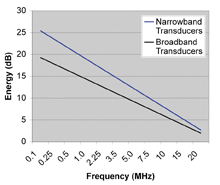 |
Potential increase in sensitivity using a tuned square wave pulser versus a spike pulser as a function of transducer center frequency. |
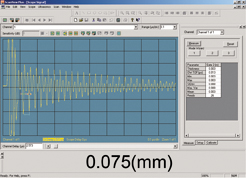 |
Response using a Model 5073PR 75 MHz bandwidth pulser-receiver with a V215-BA-RM 50 MHz permanent delay contact transducer coupled to a 0.075 mm (0.003") metal shim |
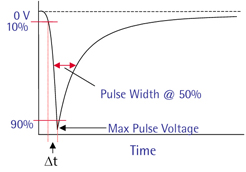 |
Spike excitation features sharp rise times adjusted by energy and damping values. |
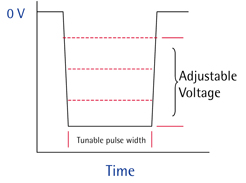 |
Square wave has controlled rise and fall times with directly adjustable voltage and pulse width. |
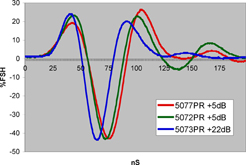 |
A-scan comparison between 5073PR and 5072PR with 50 ohm damping and energy Position 1 to 5077PR set at 100 volts and tuned for frequency optimization. Gain set to noted dB level to normalize signal height from a 20 MHz delay line transducer. |
Transducers
Olympus manufactures a wide range of transducers for conventional and high frequency applications. Transducers with center frequencies between 50 kHz and 50 MHz are available for use with the manually controlled pulser-receiver line. We also offer transducers with frequencies above 50 MHz that may be used with higher frequency instruments available in our computer-controlled pulser-receiver family. Direct contact, delay line, dual, immersion, angle beam, normal incidence shear wave transducers and more are available.
Preamplifiers
A line of low noise preamplifiers is available in a variety of bandwidths up to 40 MHz. These preamps can be used with our pulser-receivers for increased amplification in hard to penetrate materials or to drive long cable lengths from the transducer back to a host instrument for improved signal to noise characteristics.
Transducer Characterization
Panametrics pulser-receivers have been used as the basis for both industrial and medical transducer characterization
systems. These instruments provide economical and reliable solutions for conventional, high frequency, and phased array transducer characterization.
Biomedical Applications
Panametrics instrumentation has been a choice of the discerning researcher for a variety of biomedical applications including ocular imaging, vascular imaging, tissue characterization, blood flow analysis, and bone structure characterization.
Material Characterization
Measurements on Young's Modulus and Shear Modulus of Elasticity and Poisson's ratio in non-dispersive isotropic engineering materials can be determined quickly and easily through computations based on sound velocities.
Correlation of velocity, time of flight, attenuation, and spectral content can often be related to other material properties. Grain structure, particle distribution, degree of nodularity in cast iron, polymerization in plastics, and mix ratios of liquids can all be inferred ultrasonically.
Specifications* |
|||||||||||||||||||||||||||||||||||||||||||||||||||||||||||||||||||||||||||||||||||||||||||||||||||||||||||||||||||||||||||||||||
|---|---|---|---|---|---|---|---|---|---|---|---|---|---|---|---|---|---|---|---|---|---|---|---|---|---|---|---|---|---|---|---|---|---|---|---|---|---|---|---|---|---|---|---|---|---|---|---|---|---|---|---|---|---|---|---|---|---|---|---|---|---|---|---|---|---|---|---|---|---|---|---|---|---|---|---|---|---|---|---|---|---|---|---|---|---|---|---|---|---|---|---|---|---|---|---|---|---|---|---|---|---|---|---|---|---|---|---|---|---|---|---|---|---|---|---|---|---|---|---|---|---|---|---|---|---|---|---|---|---|
|
|||||||||||||||||||||||||||||||||||||||||||||||||||||||||||||||||||||||||||||||||||||||||||||||||||||||||||||||||||||||||||||||||
|
ORDERING INFORMATION: Each model is shipped with a power cord and operator manual. Transducers and cables are sold separately. *All specifications are subject to change without notice. |
|||||||||||||||||||||||||||||||||||||||||||||||||||||||||||||||||||||||||||||||||||||||||||||||||||||||||||||||||||||||||||||||||
